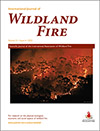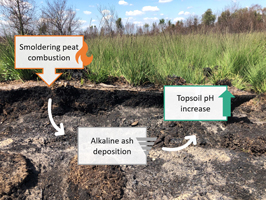
International Journal of Wildland Fire
Volume 31 Number 6 2022
WF21072Reconstructing seasonal fire danger in southeastern Australia using tree rings
 , Stephen B. Stewart, Carly Tozer, Doug Richardson, Craig Nitschke, James Risbey, Andrew Dowdy, Matthew Brookhouse, Paul Fox-Hughes
, Stephen B. Stewart, Carly Tozer, Doug Richardson, Craig Nitschke, James Risbey, Andrew Dowdy, Matthew Brookhouse, Paul Fox-Hughes  , Mike Peterson and Patrick J. Baker
, Mike Peterson and Patrick J. Baker
We use a tree-ring network from southeastern Australia to reconstruct the number of high fire-danger days in January–March, as reflected in the Forest Fire Danger Index (FFDI). Highest quality reconstructions in southwestern Tasmania indicate that the recent persistent increase in seasonal fire danger is unmatched over the past 430 years.
WF21072 Abstract | WF21072 Full Text | WF21072PDF (3.4 MB) | WF21072Supplementary Material (784 KB) Open Access Article
WF21144Comparing geostationary and polar-orbiting satellite sensor estimates of Fire Radiative Power (FRP) during the Black Summer Fires (2019–2020) in south-eastern Australia
 , Karin J. Reinke, Mariela Soto-Berelov, Chermelle Engel and Simon D. Jones
, Karin J. Reinke, Mariela Soto-Berelov, Chermelle Engel and Simon D. Jones
We explore the utility of next-generation satellite observations of fire intensity during the Black Summer Fires. We found that these new datasets capture similar patterns to the previous generation earth-observation data but offer greater temporal detail. These results are significant as they open new opportunities for active fire monitoring.
WF21144 Abstract | WF21144 Full Text | WF21144PDF (4.5 MB) Open Access Article
WF21176An analysis of factors influencing structure loss resulting from the 2018 Camp Fire
 , Jason Moghaddas, David Schmidt, J. Shane Romsos, David B. Sapsis, William Brewer and Tadashi Moody
, Jason Moghaddas, David Schmidt, J. Shane Romsos, David B. Sapsis, William Brewer and Tadashi Moody
This study analysed loss data from the 2018 Camp fire and found numerous building characteristics that were important determinants of structural survival, including double paned windows, enclosed eaves, ignition-resistant roofs/siding, age of structure, lack of vents, improvement value, and decks. Defensible space had only weak associations with structure loss in this data set. Mobile homes were far more likely to be destroyed.
WF21176 Abstract | WF21176 Full Text | WF21176PDF (6 MB) Open Access Article
WF20177Preventing wildfires with fire permits in rural Edson, Alberta
This study examines wildfire prevention by rural residents in the Edson Forest Area, Alberta, Canada. Awareness of the wildfire risk was high, but there was little recognition that using fire for agricultural purposes contributed to wildfires in the area. Many respondents undertook wildfire prevention activities while using fire for agricultural purposes. Many fire users had not applied for a fire permit. Information about fire permits – and experiencing a wildfire in the Edson Forest Area – influenced wildfire prevention activities.

Peatlands need acidic soil conditions for maintaining proper health and functioning. Wildfire-produced ash is often alkaline, thus potentially impacting soil pH. We observed that soil pH was not affected by the ash generated during a peatland wildfire.
WF21150 Abstract | WF21150 Full Text | WF21150PDF (6.9 MB) | WF21150Supplementary Material (1.3 MB) Open Access Article
WF22005Do bird communities differ with post-fire age in Banksia woodlands of south-western Australia?
We explored bird responses to fire in threatened Banksia woodlands in south-western Australia and found post-fire age had little or no effect on the overall bird community. Two species responded to post-fire age but were most abundant early post fire, suggesting the bird community is adaptable to a range of prescribed burning regimes.
WF21088Firebrand transport from a novel firebrand generator: numerical simulation of laboratory experiments
A combined experimental and numerical study of firebrand transport is presented. A novel firebrand generator was built to produce specific-shaped burning firebrands and measure landing distributions. A physics-based model is used with four different drag sub-models to reproduce experimental results and results are obtained with various degrees of fidelity.



